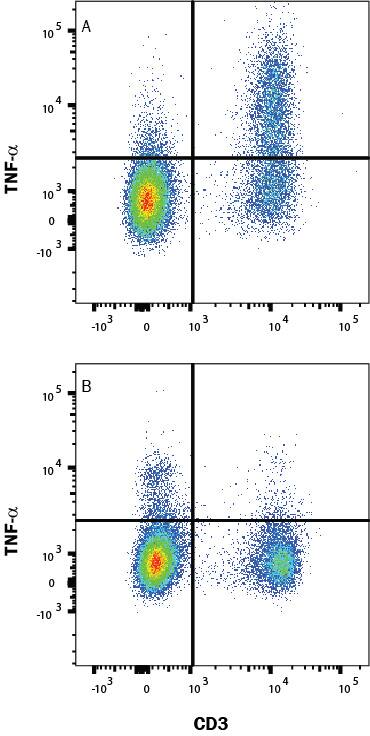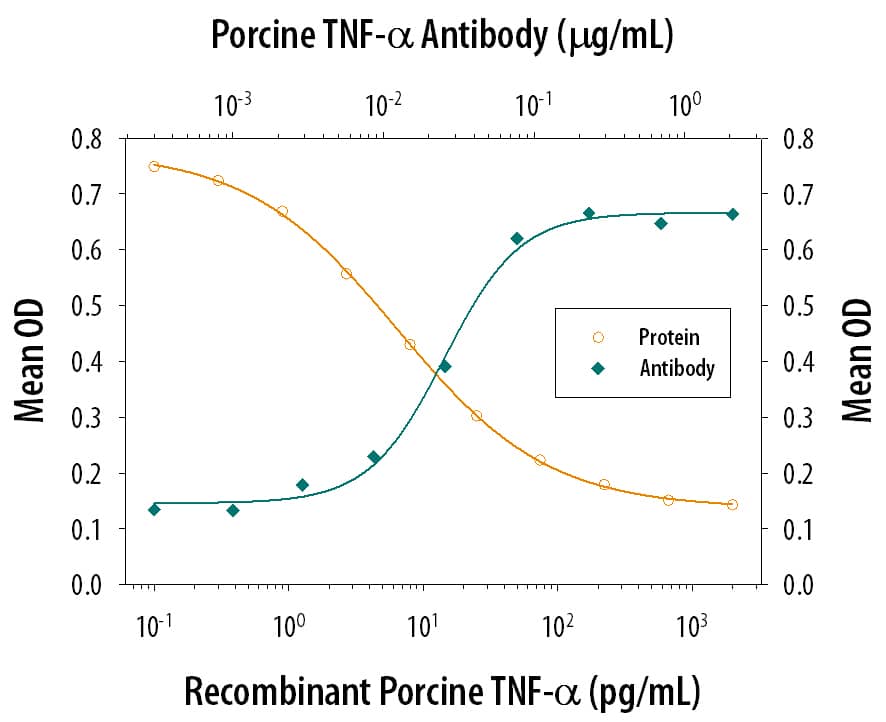TNF-alpha Products
TNF-alpha (Tumor necrosis factor alpha) plays a central role in inflammation, immune system development, apoptosis, and lipid metabolism. TNF-alpha was first identified as a cytotoxic factor produced by macrophages capable of killing mouse tumor cells. It is the prototypic ligand and along with Lymphotoxin-alpha, were identified as the first members of the TNF superfamily. Active TNF-alpha and other members of the TNF superfamily exist as a homotrimer with high structural homology. Receptor binding occurs at the interface of two TNF-alpha monomers. And receptor activation occurs when all three monomer interfaces are engaged with a receptor. For TNF-alpha, receptor binding and activation occurs through TNF R1 or TNF RII, and subsequently leads to activation of NF-kB or MAPK signaling pathways. Another pathway that TNF-alpha can activate utilizes the death domain of TNF RI to induce apoptosis. TNF-alpha promotes the inflammatory response largely through NF-kB signaling, and inhibition of TNF-alpha has proven successful in treating many autoimmune disorders. TNF-alpha is also present on the cell surface as membrane-bound TNF-alpha can induce the lysis of neighboring tumor cells and virus infected cells. TNF-alpha protein is translated as a type II transmembrane protein containing an N-terminal transmembrane domain. The soluble cytokine is released from its cell-anchoring TM domain by proteolytic processing by metalloproteases.
121 results for "TNF-alpha" in Products
121 results for "TNF-alpha" in Products
TNF-alpha Products
TNF-alpha (Tumor necrosis factor alpha) plays a central role in inflammation, immune system development, apoptosis, and lipid metabolism. TNF-alpha was first identified as a cytotoxic factor produced by macrophages capable of killing mouse tumor cells. It is the prototypic ligand and along with Lymphotoxin-alpha, were identified as the first members of the TNF superfamily. Active TNF-alpha and other members of the TNF superfamily exist as a homotrimer with high structural homology. Receptor binding occurs at the interface of two TNF-alpha monomers. And receptor activation occurs when all three monomer interfaces are engaged with a receptor. For TNF-alpha, receptor binding and activation occurs through TNF R1 or TNF RII, and subsequently leads to activation of NF-kB or MAPK signaling pathways. Another pathway that TNF-alpha can activate utilizes the death domain of TNF RI to induce apoptosis. TNF-alpha promotes the inflammatory response largely through NF-kB signaling, and inhibition of TNF-alpha has proven successful in treating many autoimmune disorders. TNF-alpha is also present on the cell surface as membrane-bound TNF-alpha can induce the lysis of neighboring tumor cells and virus infected cells. TNF-alpha protein is translated as a type II transmembrane protein containing an N-terminal transmembrane domain. The soluble cytokine is released from its cell-anchoring TM domain by proteolytic processing by metalloproteases.
| Sensitivity: | 7.21 pg/mL |
| Applications: | ELISA |
| Assay Range: | 10.9 - 700 pg/mL (Cell Culture Supernates, Serum, EDTA Plasma, Heparin Plasma) |
| Assay Range: | 31.2 - 2,000 pg/mL |
| Applications: | ELISA |
Analyzed by SEC-MALS
| Source: | E. coli |
| Accession #: | P06804 |
| Applications: | BA |
| Reactivity: | Human, Mouse |
| Details: | Goat IgG Polyclonal |
| Applications: | WB, IHC, CyTOF-ready, ICC, ICFlow, +1 More |
| Reactivity: | Human, Mouse, Rat, Canine, Fish, +1 More |
| Details: | Rabbit IgG Polyclonal |
| Applications: | IHC, WB, ICC/IF, Flow |
| Sensitivity: | 5 pg/mL |
| Applications: | ELISA |
| Assay Range: | 23.4 - 1,500 pg/mL (Cell Culture Supernates, Serum, EDTA Plasma, Heparin Plasma) |
| Assay Range: | 31.2 - 2,000 pg/mL |
| Applications: | ELISA |
| Reactivity: | Human, Mouse, Rat, Primate, Chicken, +1 More |
| Details: | Rabbit Serum Polyclonal |
| Applications: | IHC, WB, ICC/IF, ELISA, B/N |
| Reactivity: | Mouse |
| Details: | Hamster IgG Monoclonal Clone #TN3-19.12 |
| Applications: | WB |
| Reactivity: | Mouse |
| Details: | Rat IgG1 Monoclonal Clone #MP6-XT22 |
| Applications: | ICFlow, Neut |
| Reactivity: | Mouse |
| Details: | Goat IgG Polyclonal |
| Applications: | WB |
| Reactivity: | Mouse |
| Details: | Goat IgG Polyclonal |
| Applications: | WB, Neut |
| Source: | E. coli |
| Accession #: | P06804 |
| Applications: | BA |
| Source: | E. coli |
| Accession #: | P23563 |
| Applications: | BA |
| Reactivity: | Porcine |
| Details: | Mouse IgG1 Monoclonal Clone #103302 |
| Applications: | WB, ICC, Neut |
| Reactivity: | Porcine |
| Details: | Goat IgG Polyclonal |
| Applications: | WB, ICC, Neut |
| Reactivity: | Mouse |
| Details: | Rat IgG1 Monoclonal Clone #MP6-XT22 |
| Applications: | ICFlow |
| Reactivity: | Human, Mouse |
| Details: | Mouse IgG1 kappa Monoclonal Clone #6N1E7 |
| Applications: | WB, Flow, Inhibition Activity |
| Reactivity: | Porcine |
| Details: | Goat IgG Polyclonal |
| Applications: | WB |
| Reactivity: | Mouse |
| Details: | Rat IgG1 Monoclonal Clone #MP6-XT22 |
| Applications: | ICFlow |
| Reactivity: | Porcine |
| Details: | Mouse IgG1 Monoclonal Clone #103304 |
| Reactivity: | Human, Mouse, Rat, Canine, Zebrafish, +2 More |
| Details: | Mouse IgM Kappa Monoclonal Clone #P/T2 |
| Applications: | IHC, ICC/IF, Flow |
| Reactivity: | Human, Mouse, Rat, Canine, Zebrafish, +2 More |
| Details: | Mouse IgM Kappa Monoclonal Clone #TNF706 |
| Applications: | IHC, ICC/IF, Flow |
| Reactivity: | Porcine |
| Details: | Mouse IgG1 Monoclonal Clone #103314 |
| Applications: | Neut |






![Western Blot: TNF-alpha AntibodyBSA Free [NBP1-19532] Western Blot: TNF-alpha AntibodyBSA Free [NBP1-19532]](https://resources.bio-techne.com/images/products/TNF-alpha-Antibody-Western-Blot-NBP1-19532-img0007.jpg)


![Western Blot: TNF-alpha AntibodyAzide Free [NB600-587] Western Blot: TNF-alpha AntibodyAzide Free [NB600-587]](https://resources.bio-techne.com/images/products/TNF-alpha-Antibody---Azide-Free-Western-Blot-NB600-587-img0012.jpg)







![Western Blot: TNF-alpha Antibody (6N1E7) [NBP2-27223] Western Blot: TNF-alpha Antibody (6N1E7) [NBP2-27223]](https://resources.bio-techne.com/images/products/TNF-alpha-Antibody-6N1E7-Western-Blot-NBP2-27223-img0004.jpg)

![Immunocytochemistry/ Immunofluorescence: TNF-alpha Antibody (P/T2) [NBP2-34302] Immunocytochemistry/ Immunofluorescence: TNF-alpha Antibody (P/T2) [NBP2-34302]](https://resources.bio-techne.com/images/products/TNF-alpha-Antibody-P-T2-Immunocytochemistry-Immunofluorescence-NBP2-34302-img0003.jpg)
![Immunocytochemistry/ Immunofluorescence: TNF-alpha Antibody (TNF706) [NBP2-34303] Immunocytochemistry/ Immunofluorescence: TNF-alpha Antibody (TNF706) [NBP2-34303]](https://resources.bio-techne.com/images/products/TNF-alpha-Antibody-TNF706-Immunocytochemistry-Immunofluorescence-NBP2-34303-img0002.jpg)
